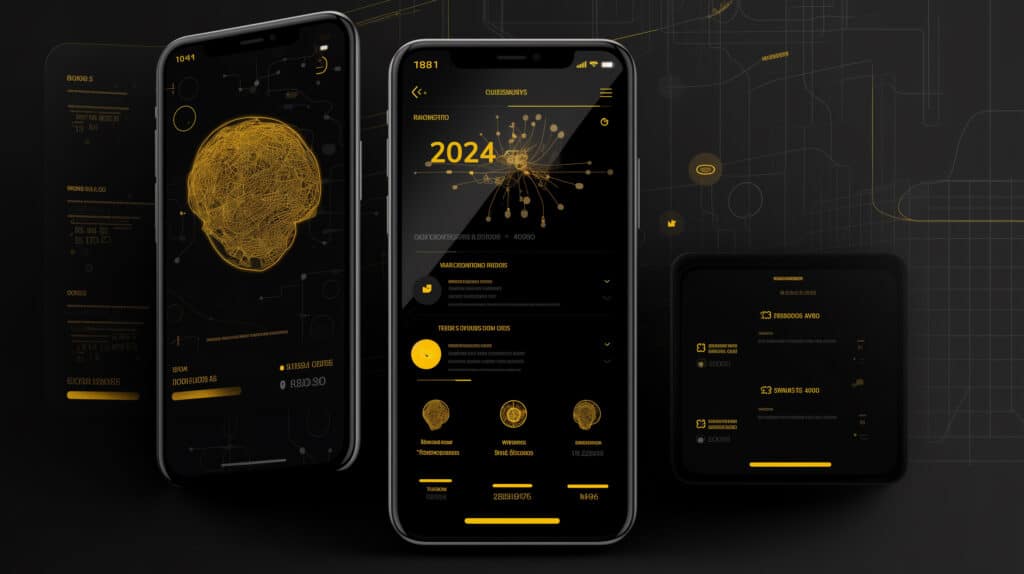

Devstars
As we approach 2024, the digital landscape presents an exhilarating yet challenging frontier for web developers and digital agencies. We live in an era where technology evolves at lightning speed, and user expectations shift just as quickly. Staying abreast of the latest trends and principles in web development is not just advantageous – it’s imperative.
The coming year will unfold new horizons in how we approach web design, prioritise user experience, and leverage technology. This evolution is not just about keeping pace with tech. It’s about setting the stage for innovative, user-focused, and sustainable digital experiences.
The importance of these evolving principles cannot be overstated. In our digital-centric world, websites can be the first and last point of interaction between a business and its customers. They are more than just digital brochures. Websites are the platforms that shape user perception, drive engagement, and catalyse business growth. Thus, understanding and implementing the right web development strategies is critical to success.
For digital agencies like Devstars, navigating this landscape means more than executing client projects. It involves a deep dive into understanding market dynamics, user behaviour, and the technological undercurrents shaping the digital world.
As a leader in web development and digital strategy, we recognise the importance of these principles in delivering top-tier, forward-thinking solutions that meet and anticipate client needs.
This article will explore the essential web development principles that should guide your strategies and execution in 2024. These principles are not just trend-based predictions. They are founded on a comprehensive understanding of the digital ecosystem and a commitment to excellence in the field.
Whether you’re a seasoned developer, a digital strategist, or a business owner looking to enhance your online presence, these insights will provide valuable guidance for the year ahead.
UX in 2024 will be all about understanding and adapting to the nuanced needs of users. It’s about creating digital spaces that are not only visually appealing but also intuitively navigable, profoundly engaging, and tailored to deliver personalised experiences. As digital interactions become as commonplace as face-to-face ones, the quality of these interactions becomes paramount.
In this context, UX is more than a mere component of web design; it’s a comprehensive approach encompassing every aspect of a user’s interaction with a website or application. Every element must be orchestrated from the initial layout design to the final thank you message to deliver a seamless, enjoyable, and effective user journey.
For Devstars and similar forward-thinking digital agencies, focusing on UX means delving into a deep understanding of user behaviour, preferences, and trends. It involves employing innovative design strategies, leveraging the latest technologies, and continually testing and refining to ensure that every digital solution meets and anticipates user needs.

Check out the WAVE Web Accessibility Evaluation Tools and see how your own website stacks up.
The ubiquitous presence of smartphones and tablets has reshaped how users access information, engage with content, and interact with the digital world. With over 55% of all website traffic coming from phones, a mobile-first approach is not a choice but a necessity for staying relevant and competitive.
Mobile-first is straightforward yet profound: designing and developing websites primarily focusing on the mobile experience. This approach flips the traditional design paradigm, which often involves creating a desktop version first and then adapting it for mobile screens.
However, as mobile usage outstrips desktop browsing, the priority has decisively shifted.
Adopting a mobile-first philosophy for digital agencies like Devstars is about understanding and aligning with the user’s context and behaviours. It’s about acknowledging that a significant portion of the audience will interact with websites on a small screen, often on the go, expecting quick, seamless access to information and services.
A mobile-first approach impacts everything from the overall design aesthetic to the technical aspects of web development. It involves creating responsive designs that adapt fluidly to different screen sizes, ensuring fast load times, and optimising touch-screen navigation.

Moreover, it’s about rethinking content layout and interaction models to suit the mobile user’s needs and limitations.
2024 is set to be transformed by a suite of cutting-edge technologies. These advancements will redefine the capabilities of websites and applications and offer unprecedented opportunities for enhancing user experience and engagement. The future of web development is poised to be shaped by innovations that will push the boundaries of what is possible in the digital space.
Technologies such as Artificial Intelligence (AI), Machine Learning (ML), and Progressive Web Apps (PWAs) could play pivotal roles. They will enable web developers and designers to create more intelligent, responsive, and user-centric solutions. Integrating these technologies will facilitate a deeper personalisation of user experiences, making digital interactions more intuitive and efficient.
Moreover, emerging technologies will also significantly impact the back-end of web development, optimising performance and scalability. This will be essential in managing the increasing demands of modern web applications and the growing expectations for instant, seamless digital experiences.
In an age where digital interactions are increasingly integral to our daily lives, the safety and privacy of online information stand as paramount concerns. The coming year will see a heightened focus on developing robust security protocols, not just as a web design feature but as a foundational principle.
This renewed focus on security responds to cyber threats’ escalating complexity and frequency. Hackers and malicious entities continue to evolve their tactics, making it imperative for web developers and digital agencies to stay several steps ahead. Implementing advanced security measures will go beyond protecting data; it will be essential in building and maintaining user trust.
In 2024, we will witness the adoption of more sophisticated security practices in web development, from the inception of a project to its launch and ongoing maintenance. This includes more robust encryption methods, regular security audits, and a proactive approach to compliance with international data protection regulations.
For agencies like Devstars, championing web development security means ensuring every project is visually appealing, functionally robust and fortified against potential digital threats. This commitment to security is not just about safeguarding data; it’s about creating a safer, more trustworthy digital environment for everyone.
In 2024, web designers are tasked with an essential challenge: creating aesthetically pleasing, environmentally conscious, and user-centric web pages. These web development principles involve strategically using visual elements, ensuring that each design choice contributes positively to the user interface and the planet.
A key aspect of sustainable web design is the thoughtful use of white space. This is more than just an aesthetic choice; it’s about creating a user interface that effortlessly guides the target audience to the most critical information. By optimising the layout and reducing visual clutter, web designers can create web pages that are easier to navigate and consume less energy, aligning with eco-friendly goals.
In this context, the role of visual elements extends beyond mere decoration. Each image, font choice, and colour scheme is selected with the target audience in mind, ensuring that the web page is engaging and efficient in its digital footprint. By balancing beauty with functionality and sustainability, web designers set a new standard for how websites are crafted, making a meaningful contribution to a more sustainable digital future.
The average website produces 1.76g of CO2 for each page view. This means a site with 100k page views/month emits 2,112kg of CO2/year. This is equivalent to driving from LA to New York and back.
Integrating SEO with good design becomes increasingly apparent as we delve into the principles of creating a well-designed website. This integration is not just about optimising content with keywords. It’s about crafting a site that resonates with potential customers through a thoughtful visual hierarchy and design elements.
One of the most crucial web design principles that directly influence SEO is the establishment of a clear visual hierarchy. This aspect of good design ensures that website visitors are naturally guided through the website. From the most crucial information to secondary elements in a way that feels intuitive and engaging. Well-designed websites leverage hierarchy to capture visitors’ attention and improve SEO by making a site more accessible and user-friendly.

Additionally, the strategic use of design elements plays a vital role in SEO. From selecting fonts to the layout and colour scheme, every choice impacts how customers perceive and interact with the website. A well-structured and aesthetically pleasing website engages visitors and signals to search engines that the site is of high quality, which is crucial for better rankings.
Agile development, which blends the strengths of various experts, plays a pivotal role in shaping a website’s design. It exemplifies how expertise – from designers to developers refine the most important elements. As we say, the right things are designed, and they are designed in the right way.
A vital aspect of this collaboration involves understanding and implementing principles like Hick’s Law, which states that the time it takes for an individual to make a decision is directly proportional to the number and complexity of choices. By applying this concept, teams can design features that streamline user decisions, saving time and enhancing the overall user experience.
Effective web design is not just about visual appeal; it’s about creating a functional space that communicates a brand’s identity and values. Here, elements like negative space are design features and strategic tools UX designers use to draw attention to the most critical information, enhancing the brand narrative.
Incorporating new features into a website is also a testament to good Agile and Collaborative Development practices. By continuously iterating and seeking feedback, teams can ensure that the website stays current with trends and remains user-centric and aligned with the brand’s identity.
This approach underscores the importance of teamwork in developing effective web design. When UX designers, developers, and brand strategists work in unison, the result is a harmonious, efficient, and successful website that truly reflects the brand and resonates with the end users.
The creation of successful websites is an intricate blend of art and strategy. The visual design, with its colour palette, layout, and typography, plays a pivotal role in this synthesis, weaving together elements that speak directly to the brand identity and the site’s specific purpose. It’s about finding the right balance ensuring that each element is in the right place to create a cohesive and engaging user experience.
For new websites, determining the appropriate visual design can seem daunting. This is where understanding the brand identity comes into play. The colour palette, for instance, is not just a selection of shades but a reflection of the brand’s tone, values, and personality. It’s about choosing colours that appeal aesthetically and resonate with the target audience, making the brand memorable and distinctive.
Another crucial aspect is ensuring that the website serves its specific purpose efficiently. Whether it’s to provide information, sell products, or offer services, every design decision must contribute towards achieving this goal. The easiest way to ensure functionality is through a well-structured navigation menu. A straightforward, intuitive navigation setup allows visitors to explore the website, enhancing the user experience easily. It’s a great way to guide users to the information or products they need without overwhelming them with choices.
At the core of these decisions is the user’s perspective. A successful website is one that not only looks visually appealing but also feels intuitive and easy to use. It’s about creating an experience that draws users in and keeps them engaged. This user-centric approach is what differentiates a good website from a great one.
If you’d like help adhering or understanding Web Development Principles, please get in touch.
Send us a brief message outlining
your project and we’ll get back to
you asap to discuss your project
in more detail.